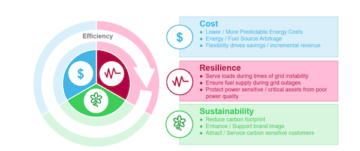
Progress in advancing sustainability outcomes during the past generation has greatly benefited from relative political and economic stability, innovation and leadership among key governments and civil society organizations. For example, the 2015 Paris Agreement to limit the global temperature increase to 1.5 degrees Celsius above preindustrial levels reflected a commitment of top American and Chinese leaders at a time of mutually supportive economic and political policies reinforced by other governments and stakeholders. Such progress is difficult to imagine now — not only because the world is more divided, but also because the skill sets and analytical tools used by sustainability professionals are increasingly outdated and unlikely to be effective in responding to newer threats that prove highly disruptive to progress. A discussion of these limitations and specific threats follows.
Current sustainability skills and tools fall short
Implementing environmental sustainability goals and programs happens primarily by responding to problems and risks that have already occurred and, in some cases, are worsening. Concepts such as pollution prevention, cradle to cradle or, more recently, the circular economy have stimulated innovative thinking but have not altered the economic fundamentals that drive the modern economy at scale. Most of the principal methods and tools used to measure and manage sustainability impacts — risk assessment, footprint analysis, environmental management systems, materiality assessments, to name a few — are primarily aimed at enabling societies to do less bad than provide more good.
This stark reality is illustrated by contrasting how financial managers and sustainability proponents evaluate environment, social and governance (ESG) issues. Financial managers focus on ESG to evaluate risks and rewards of particular assets, whereas sustainability proponents prioritize economic and technological transformation to eliminate some of the very risks where asset managers maintain investment portfolios (the fossil fuel industry, for example) to gain financial returns. The task of reconciling these contrasting approaches falls to major companies as they compile ESG reports and to government regulatory authorities that gingerly tiptoe through the political minefield of anti-ESG activists to establish minimum standards for climate transparency and other forms of reporting.
New and bigger threats are arriving
One of the world’s most prescient (and pessimistic) economic and political analysts, Nouriel Roubini of New York University, states in his recent book “MegaThreats” that “the long stretch of relative prosperity is not likely to continue much longer. We are facing a regime change from a period of relative stability to an era of severe instability, conflict and chaos. We are facing megathreats unlike anything we have faced before — and they are interconnected … most of us still imagine that the future will resemble the past. That’s a whopping mistake.”
What non-environmental megathreats should most concern us and will likely prove highly disruptive to sustainability planning? According to Roubini, they include:
1. The global debt crisis
The current U.S. private and public debt-to-GDP ratio is much higher than the peak debt during the 1930s Depression and more than twice the level incurred from World War II spending, according to the Institute of International Finance. By the end of 2021, global debt was more than 350 percent of global GDP and escalating rapidly. Trump administration economic policies, such as tax cuts for the wealthy, alone added $8 trillion to U.S. indebtedness, and this was before the the Trump and Biden administrations spent trillions responding to the COVID-19 pandemic.
Most of the principal methods and tools used to measure and manage sustainability impacts are primarily aimed at enabling societies to do less bad than provide more good.
The consequences of such indebtedness are direct and immediate. Governments will need to annually appropriate debt service interest payments in their budgets (such payments increase as interest rates rise). And competition for available resources becomes more intense. As a result, we can anticipate, even among sustainability proponents, more intense advocacy for money to implement the Biden infrastructure programs and the Inflation Reduction Act in future years. Greater levels of public and private debt also dampen the political prospects for new legislation and investments to abate greenhouse gas emissions, relieve water stress and secure decarbonization of the transportation system.
2. De-globalization of the economy
According to The Washington Post, U.S. imports from China were down 24 percent in May from the same period one year ago. In anticipation of rising costs, political disruption to business continuity through regulations, tariffs and product bans, worker shortages and future public health crises, a growing number of global companies are seeking to concentrate their far-flung suppliers and relocate manufacturing and distribution centers closer to regional markets. Meanwhile, global powers such as China and the U.S. have developed trade and investment barriers to disadvantage the other’s economy for access to raw materials necessary for electric vehicles or the ability to manufacture high-end semiconductors crucial to innovation and military preparedness.
Proponents of de-globalization seek to recapture lost jobs back to the homefront and win the competition in data technologies and for development of newer economic sectors. They have yet to articulate where the line exists between their vision of competing for the future versus destabilizing the global economic order that has lifted hundreds of millions of people out of poverty and provided abundant capital to invest in cleaner, next generation technologies. Historically, progress in advancing sustainability goals proceeds with greater confidence and momentum when not caught in a political crossfire of competing objectives of economic nationalism. The de-globalization movement, in its present incarnation, does not recognize that sustainability progress could be a casualty of its success.
3. Geopolitics reshaping the global commons
Sustainability professionals pay little attention to changes in geopolitics even though it establishes the parameters for improving environmental and other conditions on the ground. Looking in the rearview mirror, the period from 1945 to 2008 looks uncommonly peaceful and prosperous for the world in comparison to managing today’s conflicts. One consequence was that senior-level policymakers had time, incentives and some resources to devote to improving living conditions, negotiating peace and environmental treaties, and forging an international system where meaningful collaboration ensured stability for such outcomes as building a global middle class, technological innovation and investments in people and skills.
The de-globalization movement, in its present incarnation, does not recognize that sustainability progress could be a casualty of its success.
This stable world no longer exists and has been eclipsed by an intensive scramble of the two leading powers — the U.S. and China — to develop new and recommitted alliances that share their respective national and global visions. In addition, a host of middle-ranking powers— Saudi Arabia, Egypt, Iran, Japan, South Korea and Russia — seek to leverage global policy to advance their own aspirations along with regional blocs such as the European Union (which possesses economic and cultural influence but limited military power).
How to advance the sustainability agenda
These and related megathreats (the risks of artificial intelligence, a ticking demographic time bomb of global population growth) will likely define the world’s agenda for the next generation or longer. While sustainability proponents will passionately argue for a greater focus on climate change, biodiversity protections and relief for water-stressed areas, their pleas have, to date, not gained consistent policymaker attention even in Western countries.
Two changes are necessary. First, the sustainability community needs to acquire additional skill sets to better understand, communicate and gain leverage within the institutions where megathreat decisions are made, such as The World Bank, International Monetary Fund, the intelligence community and defense establishment. These skills include more authoritative knowledge of monetary and fiscal policymaking, trade and other forms of economic competition and collaboration, and military and intelligence assessments. These kinds of analyses are instrumental in defining the policy parameters and economic incentives for individual nations and the global community, and they will frequently establish the terms on whether to advance specific sustainability priorities in the coming years.
Second, in a world with a proliferating number of crises, sustainability leaders must develop new arguments connecting sustainability to the resolution of expanding megathreats to enable sustainability priorities to attain greater momentum and shape the decision-making of a rapidly changing world. To do otherwise will abandon aspirations for stability, progress and hope.
- SEO Powered Content & PR Distribution. Get Amplified Today.
- PlatoData.Network Vertical Generative Ai. Empower Yourself. Access Here.
- PlatoAiStream. Web3 Intelligence. Knowledge Amplified. Access Here.
- PlatoESG. Carbon, CleanTech, Energy, Environment, Solar, Waste Management. Access Here.
- PlatoHealth. Biotech and Clinical Trials Intelligence. Access Here.
- Source: https://www.greenbiz.com/article/megathreats-endanger-sustainabilitys-progress
- :has
- :is
- :not
- :where
- $8 Trillion
- 1
- 2008
- 2015
- 2021
- 24
- 8
- a
- ability
- above
- abundant
- access
- According
- acquire
- Act
- activists
- added
- addition
- Additional
- administration
- Administrations
- advance
- advancing
- advocacy
- agenda
- ago
- Agreement
- aimed
- Alliances
- alone
- along
- already
- also
- altered
- American
- among
- an
- analysis
- Analysts
- Analytical
- and
- Annually
- anticipate
- anticipation
- anything
- approaches
- appropriate
- ARE
- areas
- argue
- arguments
- articulate
- artificial
- artificial intelligence
- AS
- assessment
- assessments
- asset
- asset-managers
- Assets
- At
- attain
- attention
- Authorities
- available
- back
- Bad
- Bank
- Bans
- BE
- because
- becomes
- been
- before
- Better
- between
- biden
- bigger
- bomb
- book
- Budgets
- Building
- business
- business continuity
- but
- by
- CAN
- capital
- cases
- caught
- Celsius
- Centers
- change
- Changes
- changing
- Chaos
- China
- chinese
- circular economy
- civil
- class
- cleaner
- Climate
- Climate change
- closer
- collaboration
- coming
- coming years
- commitment
- communicate
- community
- Companies
- comparison
- competing
- competition
- concentrate
- concepts
- Concern
- conditions
- confidence
- conflict
- conflicts
- Connecting
- Consequences
- consistent
- continue
- continuity
- Costs
- could
- countries
- COVID-19
- COVID-19 pandemic
- crises
- crossfire
- crucial
- cultural
- Current
- cuts
- data
- Date
- Debt
- decarbonization
- Decision Making
- decisions
- Defense
- define
- defining
- demographic
- depression
- develop
- Development
- difficult
- direct
- Disadvantage
- discussion
- Disruption
- disruptive
- distribution
- divided
- do
- does
- down
- drive
- during
- Economic
- economy
- Effective
- Egypt
- Electric
- electric vehicles
- eliminate
- Emissions
- enable
- enabling
- end
- ensured
- Environment
- environmental
- Environmental Sustainability
- Era
- ESG
- establish
- establishes
- establishment
- European
- european union
- evaluate
- Even
- example
- exists
- expanding
- faced
- facing
- Fall
- Falls
- few
- finance
- financial
- First
- Fiscal
- Focus
- follows
- Footprint
- For
- Forging
- forms
- fossil
- Fossil fuel
- frequently
- from
- Fuel
- fund
- Fundamentals
- future
- Gain
- gained
- GAS
- GDP
- generation
- Geopolitics
- Global
- Global Economic
- Goals
- good
- governance
- Government
- Governments
- greater
- greatly
- greenhouse gas
- Greenhouse gas emissions
- Ground
- Growing
- Growth
- had
- happens
- Have
- Health
- High-End
- higher
- highly
- his
- historically
- hope
- host
- How
- HTTPS
- Hundreds
- hundreds of millions
- ii
- imagine
- immediate
- Impacts
- implement
- imports
- improving
- in
- Incentives
- include
- Increase
- increasingly
- incurred
- individual
- industry
- inflation
- influence
- Infrastructure
- Innovation
- innovative
- instability
- Institute
- institutions
- instrumental
- Intelligence
- interconnected
- interest
- Interest Rates
- International
- international monetary fund
- Invest
- investment
- Investments
- Iran
- issues
- IT
- ITS
- Japan
- Jobs
- jpg
- Key
- knowledge
- korea
- leaders
- Leadership
- leading
- Legislation
- less
- Level
- levels
- Leverage
- Lifted
- likely
- LIMIT
- limitations
- Limited
- Line
- little
- living
- Long
- longer
- looking
- LOOKS
- lost
- made
- maintain
- major
- manage
- management
- Managers
- managing
- manufacturing
- Markets
- materials
- May..
- meaningful
- Meanwhile
- measure
- methods
- Middle
- Military
- millions
- minimum
- mirror
- mistake
- Modern
- Momentum
- Monetary
- money
- more
- most
- movement
- much
- must
- mutually
- name
- National
- Nations
- necessary
- Need
- needs
- New
- New Legislation
- New York
- New York University
- newer
- next
- no
- Nouriel Roubini
- now
- number
- objectives
- occurred
- of
- on
- ONE
- only
- or
- order
- organizations
- Other
- otherwise
- out
- outcomes
- own
- pandemic
- parameters
- paris
- Paris Agreement
- particular
- past
- Pay
- payments
- peace
- Peak
- People
- percent
- period
- pessimistic
- planning
- plato
- Plato Data Intelligence
- PlatoData
- policies
- policy
- policymakers
- policymaking
- political
- Pollution
- population
- portfolios
- Post
- Poverty
- power
- powers
- present
- Prevention
- primarily
- Principal
- Prioritize
- private
- problems
- proceeds
- Product
- professionals
- Programs
- Progress
- proponents
- prospects
- prosperity
- prosperous
- Prove
- provide
- provided
- public
- public health
- rapidly
- Rates
- ratio
- Raw
- Reality
- recent
- recently
- recognize
- reconciling
- reduction
- reflected
- regime
- regional
- regulations
- regulatory
- related
- relative
- relief
- Reporting
- Reports
- Resolution
- Resources
- respective
- responding
- result
- returns
- Rewards
- Rise
- rising
- Risk
- risk assessment
- risks
- Russia
- s
- same
- Saudi
- Saudi Arabia
- Scale
- Sectors
- secure
- Seek
- seeking
- Semiconductors
- service
- Sets
- severe
- Shape
- Share
- shortages
- should
- skill
- skills
- Social
- Society
- some
- South
- South Korea
- specific
- Spending
- spent
- Stability
- stable
- stakeholders
- standards
- stark
- States
- Still
- stress
- success
- such
- suppliers
- supportive
- Sustainability
- system
- Systems
- tariffs
- Task
- tax
- technological
- Technologies
- terms
- than
- that
- The
- The Future
- The Washington Post
- the world
- their
- These
- they
- Thinking
- this
- though?
- threats
- Through
- ticking
- time
- to
- today’s
- tools
- top
- trade
- Transformation
- Transparency
- transportation
- Trillion
- trillions
- trump
- Trump administration
- Twice
- two
- u.s.
- understand
- union
- university
- unlike
- unlikely
- us
- used
- Vehicles
- Versus
- very
- vision
- visions
- war
- was
- washington
- washington post
- Water
- we
- were
- Western
- when
- whereas
- whether
- which
- while
- will
- win
- with
- within
- worker
- world
- World Bank
- world’s
- year
- years
- yet
- york
- zephyrnet










